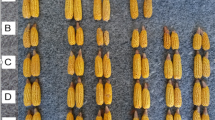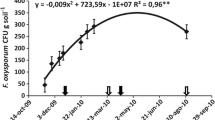Abstract
Coniothyrium minitans isolate Conio grew on both maizemeal-perlite and ground maizemeal-perlite, producing high numbers (1.6×107 conidiag−1 inoculum) of germinable conidia. Coniothyrium minitans isolate Conio applied as a preplanting soil incorporation of maizemeal-perlite inoculum at full application rate (0.6lm−2; 1011 colony forming units (cfu)m−2) significantly reduced Sclerotinia disease in a sequence of three lettuce crops grown in a glasshouse. No reduction in disease was achieved with any of the reduced rate treatments (108cfum−2) of a range of C. minitans isolates (Conio ground maizemeal-perlite at reduced rate, Conio and IVT1 spore suspensions derived from maizemeal-perlite, IVT1 spore suspension derived from oats and Contans® WG spore suspension). After harvest of the second and third crops, C. minitans maizemeal-perlite at full rate reduced the number and viability of sclerotia recovered on the soil surface and increased infection by C. minitans compared with spore suspension and reduced rate maizemeal-perlite inocula. Coniothyrium minitans was recovered from the soil throughout the trial, between 105 and 107cfucm−3 in maizemeal-perlite inoculum full rate treated plots and 101–104cfu cm−3 in all other inoculum treated plots.
Pot bioassays were set up corresponding to the inoculum used in the glasshouse, with the addition of Conio ground maizemeal-perlite at a rate corresponding to the full rate maizemeal-perlite. Coniothyrium minitans maizemeal-perlite and ground maizemeal-perlite at full rate significantly decreased carpogenic germination, recovery and viability of sclerotia and increased infection of sclerotia by C. minitans in comparison with spore suspension treatments, reflecting results of the glasshouse trials. Additionally, reduced maizemeal-perlite treatment also decreased apothecial production, recovery and viability of sclerotia compared with the spore suspension treatment, despite being applied at similar rates. Simultaneous infection of sclerotia by several isolates of C. minitans was demonstrated. Inoculum level in terms of colony forming unitscm−3 of soil appears to be a key factor in both control of Sclerotinia disease and in reducing apothecial production by sclerotia.
Similar content being viewed by others
References
Boland GJ and Hall R (1994) Index of plant hosts of Sclerotinia sclerotiorum. Canadian Journal of Plant Pathology 16: 93–108
Budge SP and Whipps JM (1991) Glasshouse trials of Coniothyrium minitans and Trichoderma species for the biological control of Sclerotinia sclerotiorum in celery and lettuce. Plant Pathology 40: 59–66
Budge SP, McQuilken MP, Fenlon JS and Whipps JM (1995) Use of Coniothyrium minitans and Gliocladium virens for biological control of Sclerotinia sclerotiorum in glasshouse lettuce. Biological Control 5: 513–522
Budge SP and Whipps JM (2001) Potential for integrated control of Sclerotinia sclerotiorum in glasshouse lettuce using Coniothyrium minitans and reduced fungicide application. Phytopathology 91: 221–227
Challen MP and Elliott TJ (1986) Polypropylene straw ampoules for the storage of microorganisms in liquid culture. Journal of Microbiological methods 5: 11–23
Coley-Smith JR and Cooke RC (1971) Survival and germination of fungal sclerotia. Annual Reviewof Phytopathology 9: 65–92
Durand A, Renaud R, Maratray J, Almanza S and Pelletier A (1994) Reactor for sterile solid-state fermentation methods. Patent No. WO 94/18306
Evenhuis A, Verdam B, Gerlagh M and Goossen-van de Geijn HM (1995) Studies on major diseases of caraway (Carum carvi) in the Netherlands. Industrial Crops and Products 4: 53–61
Gerlagh M, Goossen-van de Geijn HM, Fokkema NJ and Vereijken PFG (1999) Long term biosanitation by application of Coniothyrium minitans on Sclerotinia sclerotiorum infected crops. Phytopathology 89: 141–147
Huang HC (1980) Control of sclerotinia wilt of sunflower by hyperparasites. Canadian Journal of Plant Pathology 2: 26–32
Huang HC, Bremer E. Hynes RK and Erickson RS (2000) Foliar application of fungal biocontrol agents for the control of white mold in dry bean caused by Sclerotinia sclerotiorum. Biological Control 18: 270–276
Jones EE and Stewart A (2000) Selection of mycoparasites of sclerotia of Sclerotinia sclerotiorum isolated from New Zealand soils. New Zealand Crop and Horticulture Journal 28: 105–114
Lynch JM and Ebben MH (1986) The use of micro-organisms to control plant disease. Journal of Applied Bacteriology Symposium Supplement 1986, 115S–126S
McQuilken MP and Whipps JM (1995) Production, survival and evaluation of solid-substrate inocula of Coniothyrium minitans against Sclerotinia sclerotiorum. European Journal of Plant Pathology 101: 101–110
McQuilken MP, Mitchell SJ, Budge SP, Whipps JM, Fenlon JS and Archer SA (1995) Effect of Coniothyrium minitans on sclerotial survival and apothecial production of Sclerotinia sclerotiorum in field-grown oilseed rape. Plant Pathology 44: 883–896
McLaren DL, Huang HC, Kozub GC and Rimmer SR (1994) Biological control of sclerotinia wilt of sunflower with Talaromyces flavus and Coniothyrium minitans. Plant Disease 78: 231–235
Merriman PR (1976) Survival of sclerotia of Sclerotinia sclerotiorum in soil. Soil biology and Biochemistry 8: 385–389
Mylchreest SJ and Wheeler BEJ (1987) A method for inducing apothecia from sclerotia of Sclerotinia sclerotiorum. Plant Pathology 36: 16–20
Thompson R and Welham SJ (2000) REML analysis of mixed models. In: Payne RW (ed) The Guide to GenStat, Part 2; Statistics (pp 413–503). VSN International Ltd., Oxford, UK
Tribe HT (1957) On the parasitism of Sclerotinia trifoliorum by Coniothyrium minitans. Transactions of the British Mycological Society 40: 489–499
Trutmann P, Keane PJ and Merriman PR (1980) Reduction of sclerotial inoculum of Sclerotinia sclerotiorum with Coniothyrium minitans. Soil Biology and Biochemistry 12: 461–465
Verdam B, Gerlagh M and van de Geijn HM (1993) Biological control of Sclerotinia sclerotiorum in caraway (Carum carvi). Mededelingen van de Faculteit Landbouwwetenschappen Universiteit Gent 58: 1343–1347
Whipps JM and Budge SP (1990) Screening for sclerotial mycoparasites of Sclerotinia sclerotiorum. Mycological Research 94: 607–612
Whipps JM, Budge SP and Ebben MH (1989) Effect of Coniothyrium minitans and Trichoderma harzianum on Sclerotinia disease of celery and lettuce in the glasshouse at a range of humidities. In: Cavalloro R and Pelerents C (eds) Integrated Pest Management in Protected Vegetable Crops, Proceedings of the CEC IOBC Group Meeting Cabrils 27-29 May, 1987 (pp 233–243) A.A. Balkema, Rotterdam, the Netherlands
Whipps JM and Gerlagh M (1992) Biology of Coniothyrium minitans and its potential for use in disease biocontrol. Mycological Research 96: 897–907
Whipps JM, McQuilken MP and Budge SP (1993) Use of fungal antagonists for biocontrol of damping-off and Sclerotinia diseases. Pesticide Science 37: 309–313
Williams RH, Whipps JM and Cooke RC (1998a) The role of soil mesofauna in dispersal of Coniothyrium minitans: transmission to sclerotia of Sclerotinia sclerotiorum. Soil Biology and Biochemistry 30: 1929–1935
Williams RH, Whipps JM and Cooke RC (1998b) The role of soil mesofauna in dispersal of Coniothyrium minitans: mechanism of transmission. Soil Biology and Biochemistry 30: 1937–1940
Williams RH, Whipps JM and Cooke RC (1998c) Water splash dispersal of Coniothyrium minitans in the glasshouse. Annals of Applied Biology 132: 77–90
Author information
Authors and Affiliations
Rights and permissions
About this article
Cite this article
Jones, E., Whipps, J. Effect of Inoculum Rates and Sources of Coniothyrium minitans on Control of Sclerotinia sclerotiorum Disease in Glasshouse Lettuce. European Journal of Plant Pathology 108, 527–538 (2002). https://doi.org/10.1023/A:1019940820230
Issue Date:
DOI: https://doi.org/10.1023/A:1019940820230




